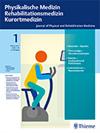局部肌肉振动减少不完全脊髓损伤的痉挛并提高功能水平:1例报告
IF 0.5
4区 医学
Q4 REHABILITATION
Physikalische Medizin Rehabilitationsmedizin Kurortmedizin
Pub Date : 2021-12-04
DOI:10.1055/a-1819-6874
引用次数: 0
摘要
摘要背景痉挛是脊髓损伤(SCI)后常见的一种损伤,对日常生活活动产生负面影响。局灶性肌肉振动(FMV)在减少脑卒中后痉挛方面具有有益作用。目的本病例报告旨在研究8周FMV对一例不完全性脊髓损伤患者痉挛和日常生活能力的影响。病例描述患者为一名26岁男性,脊髓损伤后6个月。为15人提供了24次FMV会议 每次会话分钟。结果测量包括改良Ashworth量表(MAS)和Barthel指数(BI)。结果FMV治疗导致二头肌(中位数从2点减少到1点以上)、股四头肌(中值从2点减到1点以下)和背屈(中位数从3点减到一点以上)痉挛减少,通过改良Ashworth量表测量。干预后和随访时通过Barthel指数评估的日常生活活动(中位数从67分提高到79分)。结论本病例报告表明FMV可减轻不完全性脊髓损伤患者的痉挛,改善日常生活活动。需要在更大的患者群体中进行进一步的研究来验证我们的发现。本文章由计算机程序翻译,如有差异,请以英文原文为准。
Focal Muscle Vibration Reduces Spasticity and Improves Functional Level in Incomplete Spinal Cord Injury: A Case Report
Abstract Background Spasticity is a common impairment following spinal cord injury (SCI) that negatively affects the activity of daily livings (ADLs). Focal muscle vibration (FMV) has beneficial effects in reducing spasticity post-stroke. Objectives This case report aimed to investigate the effects of 8-week FMV on spasticity and ADLs in a single patient with an incomplete spinal cord injury. Case description The patient was a 26-year-old man with 6-month post-SCI. Twenty-four sessions of FMV were provided for 15 minutes per session. Outcome measures included the Modified Ashworth Scale (MAS) and the Barthel Index (BI). Findings The FMV treatment resulted in spasticity reduction of biceps muscle (reduction from 2 to 1+point median), quadriceps (reduction from 2 to 1 point median), and dorsiflexors (reduction from 3 to 1+point median) as measured by the Modified Ashworth Scale. The activity of daily livings assessed by the Barthel Index (improved from 67 to 79 points median) postintervention and at follow-up. Conclusions This case report demonstrates that FMV reduces spasticity and improves the activity of daily livings in patients with incomplete spinal cord injury. Further research is needed in a larger patient population to verify our findings.
求助全文
通过发布文献求助,成功后即可免费获取论文全文。
去求助
来源期刊
CiteScore
1.10
自引率
25.00%
发文量
70
审稿时长
3 months
期刊介绍:
The Journal of Physical and Rehabilitation Medicine offers you the most up-to-date information about physical medicine in clinic and practice, as well as interdisciplinary information about rehabilitation medicine and spa medicine.
Publishing 6 issues a year, the journal includes selected original research articles and reviews as well as guidelines and summaries of the latest research findings. The journal also publishes society news and editorial material. “Online first” publication ensures rapid dissemination of knowledge.

 求助内容:
求助内容: 应助结果提醒方式:
应助结果提醒方式:


